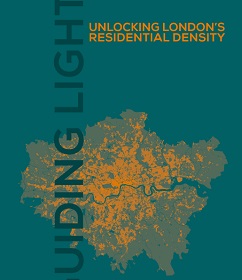Guiding light: Unlocking London's residential density
People expect good natural lighting, both daylight and sunlight, in their homes. In cities, however, external obstructions restrict the amount of light that is available.
A BRE publication, ‘Site layout planning for daylight and sunlight: a guide to good practice’ (BRE Report BR209) gives guidance in this area. It explains how to limit the loss of light to existing buildings (especially housing) and how to achieve good levels of light in new developments.
Local authorities often use the BRE Report when deciding whether to give planning permission in situations where daylight and sunlight are important.
A recent report ‘Guiding light: unlocking residential density’, written for lobby group London First, critiques the BRE Report and the way its guidance is applied in London.
Daylight surveyors GIA, the authors of the report, claim that local authorities use the BRE guidance ‘mechanistically’, preventing high density development. They point out that some historic London streets have higher levels of obstruction, and call for alternative targets in London, although they do not specify what these are.
The BRE Report itself recommends a flexible approach to applying the guidance. Its Introduction states that different target values can be used in historic city centres or areas with modern high rise buildings. An appendix to the guide explains how these can be applied. In BRE's experience, local authorities in London generally use the guidelines appropriately, allowing flexibility in tight urban environments.
GIA argue for density targets to be increased, and used as the basis for reduced daylight recommendations in areas of London. However, it is vital that new guidance recognises the human need for natural light, and doesn’t recommend conditions that may have an adverse impact on health.
Recent research has shown that daylight is more important than previously recognised. Scientists have discovered sensors in the eye, triggered by daylight, which regulate sleeping and waking and release hormones that help guard against cancer and other diseases. For this reason a new draft European standard on daylight recommends levels that are significantly higher than those in the BRE guidance.
There is an alternative approach, which involves careful daylighting design based around the principles set out in the BRE Report. High density is still possible, but the layout of new homes needs to be planned with care and appropriate window sizes specified. The historic examples cited by GIA often have larger windows on the lower floors which are more heavily obstructed. New developments also need to acknowledge their neighbours’ need for light, avoiding insensitive high rise blocks being built too close to nearby dwellings.
This article was originally published here by BRE Buzz on 14 June 2017. It was written by Paul Littlefair.
--BRE Buzz
[edit] Find out more
[edit] Related articles on Designing Buildings Wiki
- BRE Buzz articles on Designing Buildings Wiki.
- 7 ways better lighting can improve your health.
- Daylight factor.
- Health and wellbeing impacts of natural and artificial lighting.
- High quality high density homes.
- Light obstruction notice.
- Site layout planning for daylight and sunlight.
- Solar gain in buildings.
Featured articles and news
RTPI leader to become new CIOB Chief Executive Officer
Dr Victoria Hills MRTPI, FICE to take over after Caroline Gumble’s departure.
Social and affordable housing, a long term plan for delivery
The “Delivering a Decade of Renewal for Social and Affordable Housing” strategy sets out future path.
A change to adoptive architecture
Effects of global weather warming on architectural detailing, material choice and human interaction.
The proposed publicly owned and backed subsidiary of Homes England, to facilitate new homes.
How big is the problem and what can we do to mitigate the effects?
Overheating guidance and tools for building designers
A number of cool guides to help with the heat.
The UK's Modern Industrial Strategy: A 10 year plan
Previous consultation criticism, current key elements and general support with some persisting reservations.
Building Safety Regulator reforms
New roles, new staff and a new fast track service pave the way for a single construction regulator.
Architectural Technologist CPDs and Communications
CIAT CPD… and how you can do it!
Cooling centres and cool spaces
Managing extreme heat in cities by directing the public to places for heat stress relief and water sources.
Winter gardens: A brief history and warm variations
Extending the season with glass in different forms and terms.
Restoring Great Yarmouth's Winter Gardens
Transforming one of the least sustainable constructions imaginable.
Construction Skills Mission Board launch sector drive
Newly formed government and industry collaboration set strategy for recruiting an additional 100,000 construction workers a year.
New Architects Code comes into effect in September 2025
ARB Architects Code of Conduct and Practice available with ongoing consultation regarding guidance.
Welsh Skills Body (Medr) launches ambitious plan
The new skills body brings together funding and regulation of tertiary education and research for the devolved nation.
Paul Gandy FCIOB announced as next CIOB President
Former Tilbury Douglas CEO takes helm.
UK Infrastructure: A 10 Year Strategy. In brief with reactions
With the National Infrastructure and Service Transformation Authority (NISTA).
























